Would You Believe?
April 30th, 2009
I’m sorely disappointed. I wanted to begin this post with a clip from Get Smart, with Max running through the “Would you believe?” gag. Oh well, this clip below is still pretty funny. Get Smart is an interesting case study into the way early TV portrays ethnic stereotypes. Sometimes it’s truly atrocious. >_<
As you know, I’m really interested in this games and culture topic, and although I’ve discussed the issue to good length a couple of times here already, I’ve been rather apprehensive towards tackling it head on. That’s fine though as I feel better equipped for the task now than I have in the past. So I wanted to fix this issue and began writing a series of posts on games and culture. By the time I finished my introductory piece I was pretty chuffed with the results; an extended essay that covered more or less the basic framework of my idea. Writing out my ideas in full made me realize the great injustice that is the lack of discussion on games + the culture, linguistics and anthropological realms. With a primer written up in solid english, I figured that I owed it to the disciplines to allow this topic to receive the attention it deserves and went to the only place that I figured would accept it; GameSetWatch. Turns out the Mr. Carless really liked my piece and offered me a biweekly column on the site.
I guess I have ample opportunity to discuss this issue now, right? You can read my article here:
Column: ‘Lingua Franca’ – The Place Of Games In Culture
The name lingua franca means the prime language adopted in a multilingual community. I hope to discuss not just culture, but the linguistics side of things too, in the column. Because after all language = culture. I’ll post links to any new external pieces here, as I always do. For now, I have to clear up some homework and then figure out how to overcome stage fright for the next column entry.
Cross Blog Dialogue: GTA: Chinatown Wars #3
April 28th, 2009

I bet you were thinking we’d packed up this charade already. I mean after all, GTA: Chinatown Wars has hit the wall when it comes to games sales, it’s perhaps a month old now, it’s never going to see any further discussion until the game is channel though a series of crusty, cliched retrospectives.
No, Steven and I aren’t like that. We see our work through to the bitter end. There’s nothing bitter about this round though, I think we’re hitting some nails on the head. It’s just a pity that there’s been a complete lack of discussion surrounding this title (I mean seriously, what’s up with that?!). Nevermind, the GTA Power DuoTM have dished out another serving, so get tucked in, and if you’re enjoying this sleeper hit then why not join in too?
Need a refresher?
Cross Blog Dialogue: GTA: Chinatown Wars #1
Cross Blog Dialogue: GTA: Chinatown Wars #2
—
Daniel: The music initially bothered me as it just sounded like irritable chip tunes with some overlayed synthesizes, but it’s not actually too bad. It loops regularly like you said, but I don’t find that it grates too often. I particularly enjoy the music as played in this trailer, sounds perfectly suited to the cops-and-robbers nature of this game.
All of my in-game options are default, so I have the drive assist on and I don’t use the on-road arrow markers. Driving is mostly great, the biggest issue is the headway the camera provides, but it’s not too problematic and you can always refer to the mini-map as you drive. Occasionally the screen switching will make driving hazardous. The feel of the driving reminds me a lot of Micro Machines on the Megadrive and PSone, particularly when you’re stuck in a pursuit with the police. I also like how it’s easier to drive and fire, which was always a problem for me in the other titles.
I think Micro Machines is a pretty good comparison to make with this title, particularly with the visual design. The props and architecture littering the landscape jump out at you, it’s like a digital pop-up book (you remember those right?). Even more so in GTA: Chinatown Wars with the broader lines and more intricate architecture. The original two GTA games weren’t so much like this were they? Although buildings were 3D models, the camera was strictly top down, giving the game a different aesthetic vibe. Can you speak a little more about the differences here, as well as any other ties to the early games?
It’s interesting that you don’t feel so compulsed to explore the environment. Perhaps the opposite will occur when I play GTA IV and realize that the map is the same. Are there enough changes in the environment to keep you interested, that is with the new perspective, rendering and CW specific areas (gas stations, safe houses etc.)? Or does it just feel wholly derivative?
Lastly, one of the commenters in the last post mentioned that you can drag the icons from the PDA menu onto the quick launch. I tried this but it didn’t seem to work, maybe I’m doing it wrong. What about you?
Steven: Despite looping fairly frequently I have to say that I quite like the game’s soundtrack. It manages to cover different genres surprisingly and if I get bored of one station I can easily (and perhaps more importantly, quickly) change to a new one. I have to say that I was very curious as to how Rockstar would approach radio stations and the game’s soundtrack in Chinatown Wars, given the limitations of the DS. I knew they would find a compromise but I was expecting a lot less variety than what we got in the final product. Like the rest of the game, it’s quite a technical achievement when you consider that it also features some voices that come from the pedestrians. Let’s be honest, they didn’t need to include any voices in the game, it wouldn’t have affected the experience in any way and yet they did anyway. They sure do love their attention to detail. I also like how a lot of the game’s tunes are real songs, with the main theme song being created specifically for the game (as far as I know). That’s pretty cool if I say so myself.
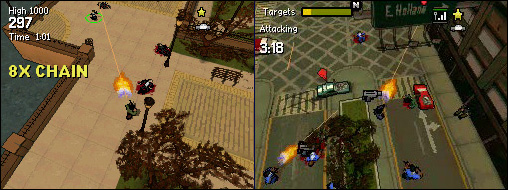
I agree that the game gives a Micro Machines vibe while driving and as you say, for the most part driving around Liberty City is great. I liked how the way cop chases work kind of taught you how to drive around the city better, avoiding cars and objects at higher speeds while also allowing you to lose the cops fairly quickly if you accidently touched them. Of course the driving assists help here, making sharp corners a lot easier than they otherwise would be but with or without the aid, weaving in and out of traffic and reaching a destination is a lot easier than it arguably should be in a top-down game like this one. I also found that changing the game’s GPS options so that arrows would be displayed on the top screen helped out as well, as it meant not having to glance down to the bottom one occasionally in order to make sure I was still going the right way. Firing at enemies while driving is easy too, as you say and I like how when you are side-by-side with another vehicle the shots you fire are aimed at that vehicle rather than randomly. It’s a nice, subtle touch. I find what you say interesting when you compare Chinatown Wars – particularly the visual style – to Micro Machines, using a pop-up book as an example. While I can see where you’re coming from, my (admittedly foggy) memory of Micro Machines is that the objects surrounding the tracks were quite simple and kept that way to ensure that you followed the track and didn’t get confused by any clutter. Chinatown Wars is refined in a similar way but is certainly not simplistic with a lot more on screen and of course attention to detail. In fact I am still constantly surprised by just how much detail is in the game. It’s just, stunning.
As for comparing it to the older, isometric GTA games, I will be honest and say that I can’t. It has been a long time since I played those and my memory just would not be able to do any comparisons justice. Playing through Chinatown Wars has sparked an interest in playing those two titles again though (plus GTA: London) so I can relive some childhood memories. In fact, I think it would be awesome to see the games released on the PSN/XBLA services. It would compliment GTA IV (and beyond) nicely I think. Hopefully we see something along those lines happen shortly but if not, I’m sure I can find copies of the games on the net somewhere.
There are enough changes in CW’s version of Liberty City so it hasn’t been derivative at all. As I explained in one of our earlier exchanges, there is less motivation to go out and explore because I do feel like I already know the city well enough, but subtle things like road changes and locations of certain things such as service stations are enough that whenever I am out on a drive the place is never boring. Add in the random events that can happen (again, something I’ve mentioned in a previous exchange) and the game remains compelling the entire time. I guess I am just approaching the city differently this time, not looking absolutely everywhere for hidden cars or things like that because I feel like I already know whether a car is going to be there or not. Yet I also feel like I am missing things, like possible easter eggs or hidden goodies. I feel like I have only scratched the surface of Liberty City and because of this I’ve started to explore a little bit more thoroughly in recent sessions with the game. What about you, how are you finding the city and have you stumbled upon anything cool or hidden? Based on what you have heard from me, do you think you will explore GTA IV when you play it or that you will be a bit more blasé because you will recognize some locations?
Daniel: Before I get into it, I did actually get the quick launch shortcuts working, so big call out to lis for sharing that with us.
I dig the pedestrian voices too, they really chip away at sad social stigmas and all that. Always gives me a chuckle. I agree, Micro Machines often pushed most of the household commodities to the side, unless they created the track design itself (acting as ramps, markers and so forth). Chinatown Wars is much more dense in that regard, which as you nudge at, is what forms part of its beauty; there is so much to visually take in. Sometimes I just want to quit a mission just to mosey around at some of the visuals for a bit. Last week on Co-op (online video games show, ex-1UP’ers) they discussed this title with unfortunately less enthusiasm than I had hoped. One of the interesting commentaries was that Chinatown Wars is a continuation of the design from the Tony Hawk threesome for DS, which I also think is very true.
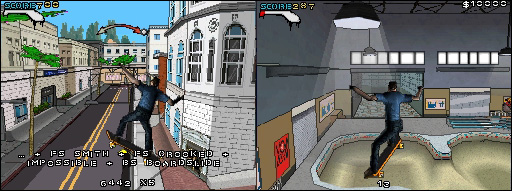
Actually, you can download the original two GTA titles through the RockStar website free of charge. I have trouble accessing it though, might be an Opera thing, I’m not sure.
Recently I finished the main selection of missions and have been off attempting to round out the last 30% or so in hidden extras. One of the biggest surprises was the Liberty City Guns club, where you can participate in 5 or so small, arms-training mini games. The same goes for the go-kart track, with the four time trial races. Very neat. Early on I found the chainsaw which is my weapon-of-choice, very effective, doesn’t waste bullets and makes light work of enemies.
I think that when I play GTA IV, I’ll likely explore at a similar rate, it’s just a play style that I’ve adopted in recent years – gather as you go. I use to leave all extras until the end of a game for a while and then realized that it’s just better to mix the main quest and off-time activities, it’s like cheese and biscuits; they’re made to complement each other.
As I’ve discussed with you outside of these posts, I adore this hybridized approach to game design that’s been put to clever use here. Rockstar have approached old material and freshened it up with modern perks. I wouldn’t label it Neo-Retro or anything like that, but the game certainly has vintage blood running through its veins. Do you find playing this pokes at nostalgia lane a little? Is this title more of a GTA 1,2 and London or a GTA IV and San Andreas? Where do you draw the line on this spectrum?
Although I don’t have an extensive history with the series, here’s how I slice it. The overhead camera almost forces one to group this together with the earlier titles, but once you start playing, the small quirks from the newer titles begin to seep in. The density of the city, the PDA system, the set piece crashes etc. You’ve got the two games living inside one another. The DS functionality almost feels like the glue between the two. It connects the overhead play (GTA1-2) with the PDA system (GTA4), the conventional way of play (retro-esque) with the touch screen interaction (modern). There’s no doubt a push and pull effect going on, it’s marvelous and along with the presentation, colours this title a brand of it’s own.
Steven: Yeah the pedestrian voices are hilarious and hearing something like “I’m still a virgin” after you accidently bump into someone makes me smirk every time. The off-handed comments hearkens back to the more juvenile humour of the original games, which conveniently brings me to the hybridized elements that you mention. It’s almost as if Rockstar intended GTA: Chinatown Wars to be a summary of the entire franchise, combining everything you allude to (and more) in order to effectively convey what they want the series to be about. Simple additions that weren’t in GTA IV such as Rampages and the emergency services missions are staples of the series and their inclusion in CW is just one small example of something that is, arguably, a defining feature of the franchise. Throw in a handling system for the various vehicles that is quite similar to IV’s more tighter controls (Chinatown’s inclusion of assists to help make tight turns easier reminds me of the refined handling from IV); the PDA that has similar functions to the phone from IV, as well as IV’s version of Liberty City and you have a combination that, to me anyway, seems to summarise what Rockstar believes the series is about, the core of it anyway. The unique interactions using the DS stylus, as well as other DS-specific inclusions also demonstrates that while the series has a core, it also has mass potential to head in unexpected directions and constantly redefine what it can be. Whether you’re talking about using a platform successfully when no one thought it could work (Chinatown Wars) or changing one’s perspective on something ultimately familiar (GTA IV: Lost And Damned); the series has already been reinvented in unpredictable ways and I can only see that continuing with further installments. Returning to Chinatown Wars though, do you agree with me in that it seems like a summary of the franchise or if not that, then something along those lines?
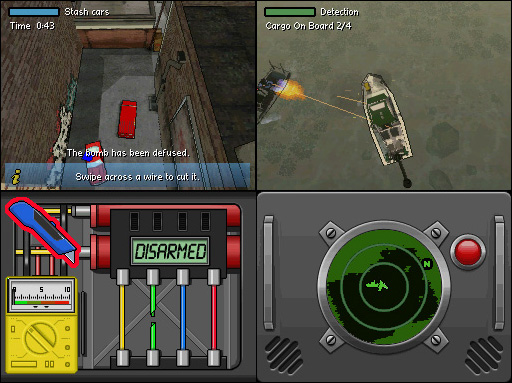
To answer your question, it does poke at my memories a little though I wouldn’t call it nostalgia. I was a kid back when I played the original games and as I’ve mentioned before, memory of them is a little hazy but subtle things here and there definitely do remind me of my time with those games and as a result, playing Chinatown Wars is almost charming. Hard to believe when you’re constantly stealing cars, killing people and being a drug dealer, but I guess when one reminisces one remembers the good old times, or something. Anyway, it’s an interesting contrast because as I’ve also said, including these past elements while also basically being a handheld version of IV (minus a decent narrative and other things though, of course) is a little weird for someone like me who has been with the series since its inception.
On Co-Op’s discussion of the show, it definitely wasn’t as in-depth as I would have expected from those guys (long time watcher of both the 1up-Show and now Co-Op) but it was still nice to hear what they thought about it and to see it being discussed when, of course, the game still seems to be flying under the radar. I’m glad the guys managed to work out a way to feature DS games in the show again too because I remember when they first started Co-Op, they mentioned that it wasn’t easy to do. Unfortunately for me I can’t comment on the comparisons to the Tony Hawk DS games as I haven’t played them.
Weapon of choice so far for me has been the flamethrower – there’s something strangely satisfying about burning the citizens of Liberty City to the ground, not to mention their cars and anything else I can set alight. If I may ask, where is this gun club? I keep on hearing about it because a little message pops up from time to time informing me of a new weapon I can try, but I haven’t stumbled upon the club throughout my travels yet. I have done the four Go-Kart time trials though which were fun and a nice addition after seeing the track in GTA IV and not being able to really do anything with it. Without spoilers, do you have any final thoughts on the story of the game now that you have finished it? What about the characters? I’m not as far as you with my progress sitting at roughly 45-55%. My thoughts on the story so far have remain unchanged; I still feel like it is just there to serve as a mission provider and nothing more which is a bit disappointing.
Finally, I have been asked a few times to try and describe what it feels like to actually play this game so perhaps it’s time we tried to do just that? To begin, I will say that at first playing Chinatown Wars felt surreal due to the reasons I’ve mentioned above: the combined elements of the series — The perspective of play on the DS; familiar inclusions such as Rampages and Vigilante missions; Liberty City from Grand Theft Auto IV – all of it feeling new and yet strangely familiar at the same time. That feeling comes from experience with the franchise though, how does it feel to someone like you who doesn’t have the same background that I do?
—
More soon (no really!)
Play Impressions (And the Rest #3)
April 26th, 2009

Here’s the next couple of titles I’m discussing in this series. Ironically both games have different titles in the US, I will refer to the PAL names.
Unirally
(Uniracers)
Although never billed as one, Sonic the Hedgehog is effectively a side-scrolling racing game. You have a mammal which can move at fast speeds, sprinting down a multi-tiered track in order to reach the goal before a fixed time limit runs out. There may be no strong indication of it, but the fundamentals of a side-scrolling time trial racer are present, arguably just as much so as a platformer.
Unirally is a realization of this design; a fast moving stunt racer involving unicycles pelting down and around a side-scrolling, candy-cane roller coaster. It’s a strange concept, embedded in outfashioned, early 90s coolness, screaming words like ‘radical’ while being all the more proud of itself. The vibe is very much of the era, reminds me of TMNT and other such staples.
Developed by DMA Designs (now known as RockStar North) Unirally sees you select a personified unicycle to partake in a series of race and stunt challenges making up a tour. Each tour has five tracks, one of those is a stunt track where you must reach X score, the others are all races against another cycle.
Unirally is undeniably slick, particularly so when you warm yourself firmly into the game’s half trick, half racing groove. The fast moving unicycles are firmly grounded to the track thanks to the sheer velocity at which they travel. The track design complements the tight momentum by providing roller coaster like ramps and loop de loops. The level design operates on macro and micro levels with big jumps which give you enough air time for multi-task spinning, flipping and tricking on all three axes, while tighter hooks provide enough room for the quick twirl or spin to be exploited. The minute opportunities for slipping in a quick trick require greater risk, banking on your own skills as a racer. To begin with you won’t need to step out of your comfort zone to exploit every possible hook, but the more you play, the more the game leans you in that direction. Landing tricks influence speed, which ultimately affect the out come of each race, so both the tricking and racing mechanics are equally important to race strategies.
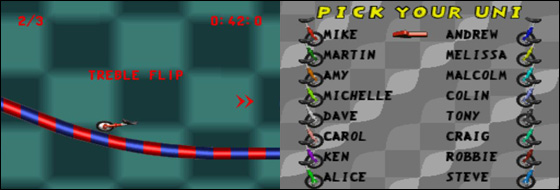
It’s a bit like a 16-bit Tony Hawk or SSX, squeezing style out of every nuance in the environment. It’s when the game hits the tertiary-like levels of difficulty that Unirally really comes into it’s own. The intensity of the tougher races demand consistent risk and mastery of the environment. The difficult is wholly fair, and there are enough gaps in the competitor’s play style to exploit, and really that’s what the difficulty amounts to; copious amounts of cheap exploitation of the environment. When they’re not busting flips, you ought to be if you want to stay in the game. Unirally illustrates this point clearly as the game is sure to keep the opposition in frame, always nudging you to step it up.
Definitely one of the more inspired SNES games I’ve enjoyed, making it difficult not to recommend. A real oddball, that makes use of its unconventional context. I’m glad I could return to this title for a thorough play through.
Lylat Wars
(StarFox 64)
Like Unirally, Lylat Wars (having some trouble with PAL-NTSC name disparities today) was a title I played in my youth, but never owned my own copy until recently. EDGE’s The 100 Best Videogames print magazine among others have likened this title to a Saturday morning cartoon, an analogy that I want to work on a little.
The overall thematic package presents itself in such a way. The anthropomorphic characters and space combat premise feel like familiar staples to the kids entertainment genre. Besides the obvious presentational similarities, the branching play routes connecting the varied set piece events foster excitement and surprise. The levels themselves aid in the game’s diversity by providing their own crossroads at the same time variables are ticking away in the background, judging your performance, deciding which level to send you next. It’s this constant switching between modes of operation that makes Fox McCloud’s romp such an exciting ride.
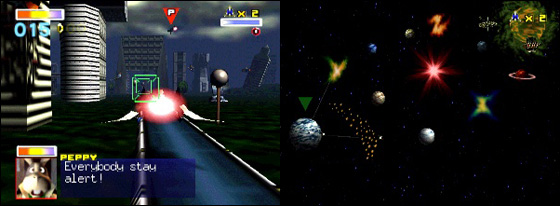
The implementation of the Starfox team during gameplay is also one of the tricks that Nintendo use to mix up the gameplay composition. Neglecting a fellow pilot in need (and man, aren’t they always in need of some assistance?) will result in a lack of assistance later in the game.
Lylat Wars is an intelligently designed game, Nintendo pull out many clever design tricks which all strengthen the overall package in different ways. Presentation wise, Lylat Wars is historically one of their best, strong voice acting, cinematic camera angles and good use of hardware (including the rumble pak).



 Game Design Companion: A Critical Analysis of Wario Land 4 - $7.99
Game Design Companion: A Critical Analysis of Wario Land 4 - $7.99 Level Design: Processes and Experiences
Level Design: Processes and Experiences Speed Boost: The Hidden Secrets Behind Arcade Racing Design - $5.99
Speed Boost: The Hidden Secrets Behind Arcade Racing Design - $5.99 Adventures in Games Analysis: Volume I - $5.99
Adventures in Games Analysis: Volume I - $5.99







